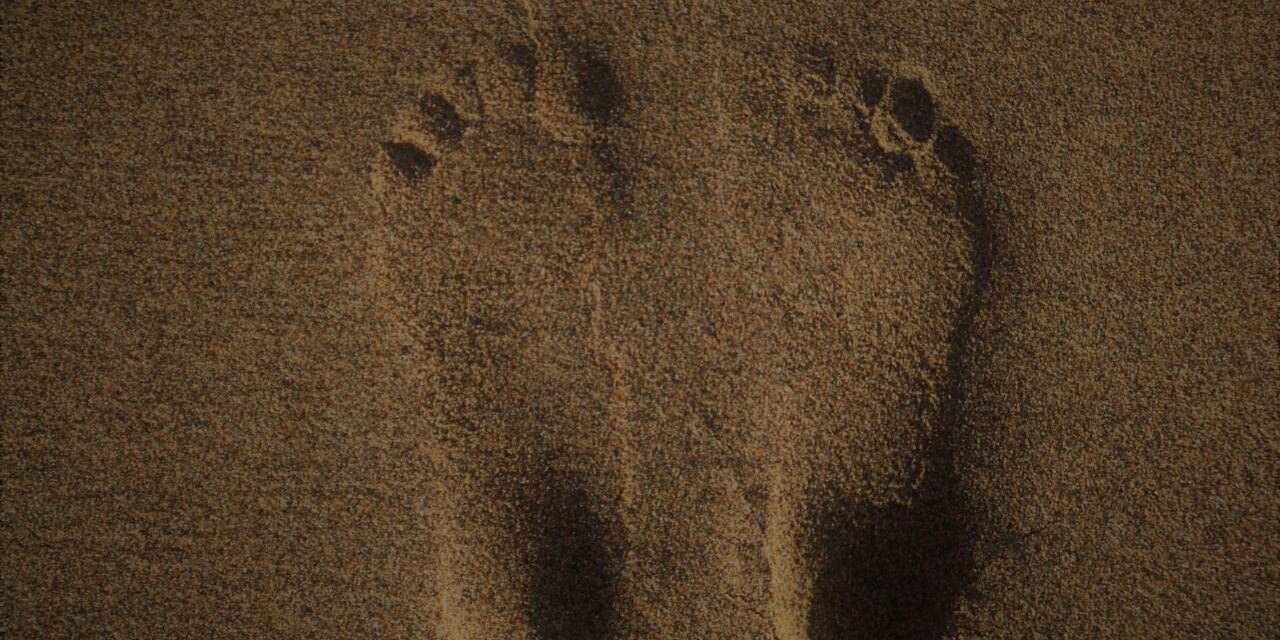As we walk through the annals of history, our ancestors leave behind fascinating imprints that connect us to our past in unexpected ways. Beyond written records and genetic analyses, one often-overlooked historical marker lies right beneath our feet: the shape of our feet themselves. The study of foot shape and ancestry offers a unique lens through which we can trace our heritage and gain insight into the lives of those who came before us.
The human foot is an engineering marvel, a complex structure crafted through millions of years of evolution. Its form and function have adapted to suit various environments and lifestyles, making it a powerful tool for understanding our lineage. Archaeological evidence reveals that footprints have been left by our ancestors dating back thousands of years, providing invaluable glimpses into their daily lives and movements.
One of the most famous footprints in history is the Laetoli footprints discovered in Tanzania, Africa. These footprints, believed to be around 3.6 million years old, were made by early hominins, possibly Australopithecus afarensis. Preserved in volcanic ash, they offer a remarkable snapshot of our ancestors’ foot shape and gait, shedding light on their behavior and interactions. The study of these footprints has revolutionized our understanding of early human bipedalism and has become a crucial piece in the puzzle of human evolution.
Moving forward in time, ancient civilizations also provide clues about the importance of foot shape in historical context. The footwear worn by different cultures throughout history can tell us much about their lifestyles, socio-economic status, and geographical locations. From the simple sandals of ancient Egyptians to the intricately designed shoes of Roman aristocrats, foot shape and footwear reflect the specific needs and preferences of each society.
Moreover, foot shape has been influenced by cultural practices, particularly in the case of foot binding in ancient China. For centuries, young girls from privileged families endured the painful process of foot binding, a practice that resulted in severely deformed feet. The shape of a woman’s foot became a status symbol, indicating her belonging to the elite class. Despite its abolition in the early 20th century, foot binding had a profound impact on the genetic expression of foot morphology in subsequent generations, leaving a lasting historical legacy.
In the study of genealogy, understanding foot morphology can complement traditional research methods and fill in gaps in ancestral narratives. While written records may be incomplete or lost over time, footprints in ancient artifacts, paintings, and sculptures can serve as a visual testament to our ancestors’ existence and experiences. By analyzing the foot shape of individuals depicted in historical art or unearthed remains, researchers can gain valuable insights into their heritage, migratory patterns, and cultural affiliations.
Advancements in genetic research have further strengthened the link between foot shape and ancestry. Scientists have identified specific genes responsible for foot morphology, providing a deeper understanding of how certain traits have been inherited across generations. Genetic studies have revealed that certain foot characteristics are more prevalent in particular ancestral groups, allowing for the identification of genetic footprints that align with genealogical histories.
Unraveling the Evolution of Human Feet: Ancestral Origins
The story of the human foot begins millions of years ago with our early hominin ancestors. The emergence of bipedalism, the ability to walk on two feet, is one of the most significant milestones in our evolutionary history. Hominins such as Australopithecus afarensis, dating back over 3 million years, walked upright, but their feet still retained some characteristics suited for climbing trees. Their transitional feet offer a glimpse into the evolutionary shift from arboreal to terrestrial locomotion.
As hominins continued to evolve, their feet underwent crucial changes to accommodate their changing lifestyles. The Homo genus, which includes Homo erectus and Homo neanderthalensis, showcased further adaptations that allowed them to thrive in diverse environments. Homo erectus, considered the first widespread human ancestor to migrate out of Africa, developed a more modern-like foot, which facilitated efficient long-distance walking and endurance during their travels to different regions.
The ice-age era saw another pivotal moment in human foot evolution with the appearance of Homo neanderthalensis, commonly known as Neanderthals. Their robust feet were perfectly suited for life in cold climates and rugged terrains, as they exhibited a highly stable foot arch and robust toes for gripping and walking over uneven surfaces. The unique foot adaptations of Neanderthals were a testament to their successful adaptation to the challenging conditions of the Ice Age.
Around 200,000 years ago, our own species, Homo sapiens, emerged in Africa and began a remarkable journey of migration across the globe. As our ancestors dispersed to various continents, their feet had to adapt to the specific challenges posed by diverse environments. Those who settled in regions with soft terrains developed broader feet, while those in rocky areas evolved with more arch support and sturdier toes.
Fast-forward to the present day, and we witness a diverse array of foot shapes and sizes across the global population. The human foot has undergone a complex interplay of genetic and environmental factors, leading to a rich variety of footprints we observe today. Some populations still exhibit more archaic foot characteristics that reflect their ancient ancestors’ adaptations, while others display more modern traits indicative of their unique evolutionary paths.
Modern lifestyles have also influenced foot morphology. The widespread use of shoes has introduced a new dynamic in human foot evolution. Different types of footwear can affect the natural development of the foot, leading to variations in arch height and toe alignment. Understanding these contemporary changes is essential in discerning the true nature of foot diversity in the context of evolution.
Advancements in genetics and paleoanthropology have provided exciting insights into the evolutionary history of human feet. By analyzing the DNA of ancient hominin remains and studying well-preserved fossil footprints, scientists continue to unravel the intricate story of human foot evolution. Each new discovery adds another chapter to the narrative, deepening our understanding of our shared ancestry and the remarkable journey that led to the diverse footprints we see today.
From Flat to Arched: Unearthing Ancestral Foot Shape Variations
The human foot, with its intricate design and remarkable functionality, has evolved over millennia to suit the diverse environments in which our ancestors lived. A fascinating aspect of this evolution is the variation in foot shapes found among different ancestral groups. From flat feet to high arches, examining these foot shape variations sheds light on the remarkable adaptability and genetic diversity that have shaped the human experience across the ages.
One of the most noticeable differences in foot shape across ancestral groups is the variation in arch height. The arch of the foot acts as a natural shock absorber, distributing the weight of our bodies and enabling efficient movement. People with high arches possess a more pronounced curve along the middle of their feet, which may make their footprints look more “C-shaped” when walking on soft surfaces. On the other hand, individuals with flat feet have minimal arches, with their entire sole touching the ground.
Studies have shown that arch height is influenced by a combination of genetic factors and lifestyle. For instance, some populations with a predominantly nomadic history, such as certain indigenous groups, exhibit higher arches, likely a result of adaptation to walking long distances on varied terrains. Conversely, populations with a history of wearing shoes from an early age may have lower arches due to the support provided by footwear during development.
Toe alignment is another significant aspect of foot shape variation. In many ancestral groups, the alignment of the toes can differ, with some individuals having toes that are more evenly spaced, while others may have a dominant big toe or toes that appear closer together. Toe alignment plays a crucial role in balance and stability, affecting how individuals walk and run.
Interestingly, toe alignment can also be influenced by cultural practices and footwear choices. For example, traditional sandals or shoes with a narrow toe box may lead to changes in toe alignment over time. In some cultures, foot-binding practices, though uncommon today, have historically caused severe deformities in toe alignment and foot shape.
Beyond arch height and toe alignment, other foot features also show considerable variation among ancestral groups. The width and length of the foot, the height of the heel, and the shape of the heel bone (calcaneus) all contribute to the unique footprints that are imprinted across human history.
Studying foot shape variations among ancestral groups not only provides valuable insights into the diversity of human physiology but also has practical implications for healthcare and sports performance. For instance, individuals with certain foot shapes may be more prone to certain foot-related conditions or injuries. Understanding these associations can help in the prevention and treatment of foot ailments and provide tailored support for athletes and individuals engaging in specific physical activities.
Advancements in technology, such as 3D scanning and gait analysis, have enabled researchers to gain a more comprehensive understanding of foot shape variations and their implications. By examining footprints from ancient remains and analyzing the foot morphology of present-day populations, scientists can piece together the intricate puzzle of human foot evolution and its connection to ancestral heritage.
Tracing Footprints in History: Foot Shape and Cultural Influences
Cultural practices have played a significant role in shaping foot morphology across different societies. One of the most prominent examples is the ancient tradition of foot binding in China. For over a thousand years, young girls from affluent families endured the painful process of foot binding to achieve the coveted “lotus feet,” a symbol of beauty and social status. This practice resulted in severely deformed feet, with toes forcibly bent under the sole. As a result, women who underwent foot binding exhibited a unique and recognizable foot shape that served as a cultural marker within Chinese society.
Similarly, other cultures have employed distinct practices that influenced foot shape. Some indigenous communities, like the Maasai of East Africa, have historically practiced foot stretching. Young children’s feet are bound and stretched to create elongated toes, believed to enhance their agility and endurance. Such practices have led to foot shape variations that differ significantly from those of neighboring cultures.
Footwear has also left its indelible mark on foot morphology. The invention of shoes allowed humans to venture into new territories, protecting their feet from harsh terrains and weather conditions. However, the design of footwear has varied across cultures and time periods, with each style contributing to unique foot shape adaptations.
For instance, certain traditional footwear, such as sandals or moccasins, allowed the foot to maintain a more natural shape, offering minimal interference with its growth and alignment. On the other hand, tight and constricting shoes, like those worn in ancient Rome or later European societies, could impact the formation of the foot’s arch and toe alignment.
Geographic location and lifestyle have also played pivotal roles in influencing foot shape. People living in different environments faced diverse challenges and adapted their feet accordingly. Those residing in sandy deserts, like the Bedouins of the Arabian Peninsula, developed broader and flatter feet to provide stability while walking on shifting sands. In contrast, populations in mountainous regions might have evolved feet with higher arches and more rugged soles to navigate rough terrains.
Furthermore, the lifestyle of a community significantly impacted foot shape. Nomadic groups, who traveled long distances on foot, developed feet that were well-suited to endurance walking. On the other hand, sedentary populations engaged in agriculture or crafts might have exhibited different foot shape characteristics due to their specific physical activities.
Understanding the historical influence of cultural practices, footwear, lifestyle, and geography on foot shape not only enriches our knowledge of human history but also has relevance in modern times. Today, as we face various foot-related health issues, understanding the effects of cultural practices and lifestyle choices on foot health can inform preventive measures and treatments.
Genetic Clues in Our Soles: The Role of DNA in Foot Shape Inheritance
The human genome is a vast library of information, containing approximately 20,000-25,000 genes that determine various physical traits. While studying the genetics of complex traits like foot shape can be challenging, advancements in genomics and computational methods have made it possible to identify genes associated with specific foot characteristics.
In one groundbreaking study published in the journal Nature Communications, researchers discovered a gene called PITX1 that is strongly linked to foot arch height. The study found that variations in the PITX1 gene were associated with differences in arch height, with some individuals inheriting higher or lower arches based on their specific genetic makeup. This breakthrough finding not only shed light on the genetic basis of arch height variation but also opened new avenues for understanding the evolutionary significance of foot arches in human history.
Other studies have delved into the genetic underpinnings of toe alignment and toe length. Researchers have identified genes linked to variations in toe alignment, revealing how certain individuals may have inherited traits like a longer second toe or evenly spaced toes. These discoveries are vital in understanding the genetic diversity of foot shapes seen across different ancestral groups.
The implications of genetic foot shape analysis extend beyond the realm of modern science. By exploring the genetic signatures of specific foot characteristics, researchers can gain valuable insights into the footprints of our ancestors. Genetic analysis can provide a deeper understanding of the foot shape variations that prevailed in ancient populations and how these traits were inherited over generations.
Genetic foot shape analysis also offers a unique perspective on human migration patterns and the movement of ancestral groups across geographical regions. Different populations, shaped by their unique genetic footprints, can carry distinct foot shape traits that serve as markers of their migratory histories.
Furthermore, genetic studies can help in the identification of foot-related genetic disorders and developmental abnormalities. By pinpointing the genetic factors behind conditions like flat feet or high arches, researchers can improve early diagnosis and personalized treatments.
As the field of genetic research advances, the understanding of foot shape inheritance and its connection to our ancestral past will continue to grow. By analyzing the genetic clues hidden within our soles, scientists gain valuable insights into the story of human evolution and the enduring legacy of our ancestors.
Preserving Foot Heritage: Implications for Genealogical Research
Genealogy, the study of family history and lineage, has long been a captivating journey of discovery, unearthing the roots that connect us to our ancestors. While traditional genealogical research primarily relies on written records, oral histories, and genetic analysis, the preservation of foot heritage adds a unique dimension to this endeavor. Foot shape data, as a rich historical marker, can complement and enrich traditional genealogical research, shedding light on our ancestral heritage in ways previously unexplored.
Including foot morphology in genealogical research may seem unconventional, but it carries valuable information about our ancestors’ lives and experiences. Footprints have been a part of human history for eons, leaving indelible marks on various artifacts, cave walls, and ancient soils. Archaeological sites that preserve footprints, such as the famous Laetoli footprints, provide tangible connections to our distant ancestors, allowing us to walk in their literal footsteps.
As we trace our family history, exploring the footprints of our ancestors can offer insights into their daily activities, lifestyles, and even their mobility patterns. Foot shape variations can reveal whether our forebears engaged in activities like long-distance walking, running, or climbing, offering clues about their professions, social roles, and migration patterns.
Incorporating foot shape data into genealogical research can be especially valuable when written records are scarce or incomplete. Throughout history, many individuals and societies were not afforded the luxury of leaving written records behind. However, the footprints they left in ancient art, sculptures, and fossilized remains can help fill these historical gaps, providing a more holistic view of our ancestral heritage.
Moreover, cultural practices that influenced foot shape, like foot binding, are an integral part of the historical narrative. By understanding the significance of such practices, we gain a deeper appreciation of the customs and traditions that shaped our ancestors’ lives and contributed to the mosaic of human history.
In the age of modern genetics and advanced imaging technologies, preserving foot heritage takes on new significance. Genetic foot shape analysis can complement traditional genealogical research, providing a genetic link to our ancestors and revealing the hereditary basis of foot morphology within our families. The inclusion of foot shape data in genetic databases could pave the way for a deeper understanding of our ancestral past and uncover connections between individuals and ancestral groups separated by centuries.
As we strive to preserve and pass down our family histories to future generations, it is essential to emphasize the importance of including foot morphology in family records. Photographs, drawings, or written descriptions of foot characteristics, combined with other genealogical data, can create a more comprehensive and vibrant portrait of our ancestors.
Preserving foot heritage in genealogical research not only enriches our understanding of our ancestral past but also highlights the remarkable story of human evolution. From the nomadic footprints of early humans to the diverse foot shapes of present-day populations, our feet bear witness to the grand tapestry of our shared human journey.
In conclusion, preserving foot heritage has significant implications for genealogical research. Foot shape data adds an exciting dimension to traditional methods, complementing written records and genetic analysis to create a more complete picture of our ancestral heritage. By including foot morphology in family history records, we preserve the unique stories and experiences of our ancestors, enriching our understanding of the past and fostering a stronger connection to our shared human history. As we continue to walk through the annals of time, let us leave no footprints behind, ensuring that the foot heritage of our ancestors is preserved for generations to come.
Image Source:
- Photo by Louisa Potter: instant images





